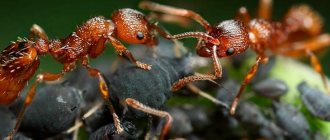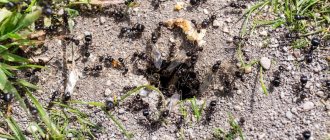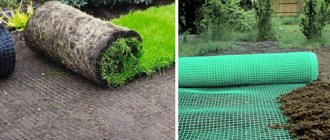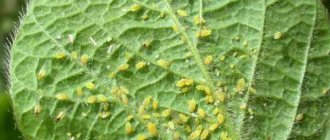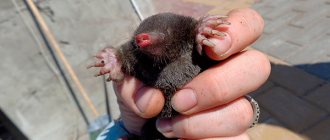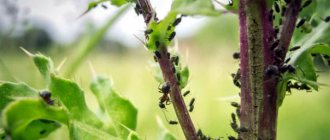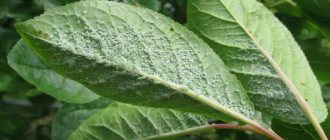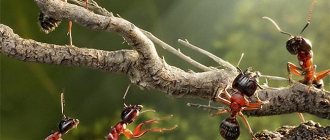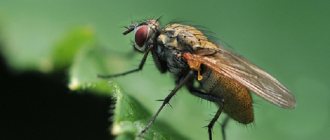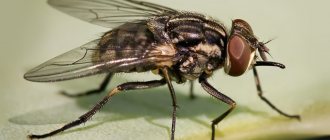Home » Garden and vegetable garden » Other » Pests
Olga Polyakova 06/10/2020
5997 Views 2 comments
Aphids are one of the most common types of insects. In total there are about 4 thousand species of aphids.
Despite external differences, the duration of the life cycle and methods of reproduction, all representatives of aphids have one thing in common - these insects parasitize trees, drinking their juices and spreading various viral infections.
Its fragile body with a weak exoskeleton is damaged by the slightest physical impact; any precipitation in the form of moderate rain can literally wash away the entire aphid colony, leaving no trace of it.
Even ants that protect aphids living in symbiosis with them are not able to repel predators such as ground beetles, lacewings or ladybugs, which “clear” trees of aphids literally within a few tens of minutes. But, despite all this, the aphid lives and thrives, because it has a huge advantage that negates all its weaknesses: a short reproductive cycle (several days) and enormous fertility. Aphids reproduce in almost any conditions (temperature from +12 to +35°C), so theoretically, in 3-4 generations, one insect can give birth to more than a hundred thousand individuals.
Due to the peculiarities of their reproduction, the aphid population is capable of occupying the entire area of the garden in a matter of days and significantly reducing the yield of trees and shrubs. In addition, it makes no difference to a small insect which plant juice to drink - garden, vegetable, greenhouse or indoor, so the fight against aphids is relevant not only for gardeners and gardeners, but also for lovers of indoor floriculture.
Reasons for the appearance of aphids in the garden
With the beginning of spring, many gardeners begin to notice the presence of parasites such as aphids in their plantings. Of course, they are interested in where such a misfortune comes from. The main reason for the appearance of aphids in summer cottages is:
- purchasing and planting infected plants,
- wind transfer of insects from neighboring areas,
- transfer of larvae by ants, on animal fur or by people themselves,
- soil damage by aphid larvae brought from other areas,
- lack of timely measures taken for processing in the garden or vegetable garden.
Effective drugs against aphid attacks
It’s too late to use chemicals; for example, currants and gooseberries have already begun to bear berries. Every gardener and gardener has safe, but very effective ingredients on hand. Folk remedies are prepared so quickly that they are suitable for summer residents who come to the garden only on weekends.
Folk remedies can destroy all types of this pest. First, let's make a solution of ammonia and water: pour ammonia into 1 liter of water, treat all plants from bottom to top. This solution will cope perfectly with small pests, and at the same time feed the plant.
This parasite is afraid of celandine decoction:
- Take celandine and fill half the bucket with it. Be sure to wear gloves, as the plant is poisonous.
- Pour in 5 liters of hot water, let it brew for 40 minutes.
- Add 200 ml liquid soap for better adhesion.
- Pour into a spray bottle and spray all plants on which colonies of parasites are observed.
If ants appear in the garden, then the same solution can be used against ants.
A vinegar solution will help destroy aphids in the garden. To prepare it you will need 70% vinegar, as well as dishwashing detergent.
For 1 liter of water, it is enough to pour 1 teaspoon of 70%, or 8 tablespoons of 9% vinegar. You only need 5 tbsp of detergent. spoons Mix everything and spray.
What types are there
This pest can be easily identified by these signs:
- Soft and translucent body without chitinous cover;
- The color of the insect completely depends on the plant on which it parasitizes, so there are black, green or white shades;
- The size does not exceed 2 mm;
- Body shape directly depends on the type of insect;
- The body of each insect is decorated with soft short fluff, and minor asymmetrical tubercles perfectly complement the appearance of each individual;
- Some insects have wings;
- Due to the presence of thin and long legs, aphids can crawl or jump, and the organs of touch are small antennae;
- Often individuals do not have distinct sexual characteristics, but there are some specimens that have received the gene responsible for such a mutation. Thanks to it, it is possible to accurately determine whether a female or a male is in front of the student.
During the winter, aphids lay eggs, from which new individuals hatch in the spring. It is not of fundamental importance for these insects to parasitize young seedlings, seedlings or trees. Scientists identify the following types:
- green, often found on seedling sprouts,
- white, affecting indoor plants,
- black or universal,
- floral, so named because of its habitat preference.
The best means of systemic action
Systemic drugs penetrate plants, making them poisonous to pests. They are suitable for processing bushes and tall trees, especially when a person cannot reach the top branches. The difference from competitors is fast absorption; the products are not afraid of rain. However, it takes several weeks to wait for the result.
5 Confidelin
Konfidelin
Confidelin quickly removes aphids from vegetables, flowers and other crops. It protects plants for 14 days and does not decompose when exposed to sunlight. The formula is resistant to humid air and does not wash off when watering. The composition is not phytotoxic and does not harm the environment. When dosed correctly, it is not dangerous to people, animals and good insects. Confideline is useful against most species of aphids. It is allowed to be mixed with other drugs.
Buyers note the rapid action of the product and the low risk of addiction. They say that plants get rid of the problem with the first spray. However, you need to work through each leaf, it takes a lot of solution. Maximum effectiveness occurs on day 3. The formula copes with any degree of infection, the effect varies depending on the concentration in the water. It has two active substances, so it affects a larger number of pests (compared to competitors).
4 Commander
Commander
The commander is aimed at getting rid of garden pests. The basis is the strong organic poison imidacloprid. It added 200 grams per liter. The drug comes in ampoules of different volumes; there are options for home plants and large gardens. It does not lose effectiveness even at very high temperatures. Quickly dissolves in water, turning into a stable suspension. Aphids do not get used to the formula; it lasts for several seasons. Low level of toxicity does not harm nature.
The Commander has the lowest consumption and an affordable price. The substance is resistant to washing off; one treatment is enough for the season. The formula is stored in the cells of trees and bushes for a month. Buyers call it most effective when applied early in the spring. For example, when the first leaves appear on roses. The result is visible after 3 days, at first it seems that there is no effect. However, the Commander cannot cope with large-scale infections alone.
3 Aktara
Aktara
Aktara is a neonicotinoid and affects the receptors of the nervous system. The main active ingredient thiamethoxam penetrates into plants, but practically does not affect the fruits. When watering bushes and trees, the formula takes up to 3 days to reach the top stems. Aktara is not afraid of high temperatures and does not lose effectiveness in the rain. Protection lasts up to a month in leaves and up to 60 days in soil. However, there is a risk of aphids becoming accustomed, which can lead to repeated infections. The drug only affects larvae; it is recommended to alternate it with other chemicals. It is compatible with most insecticides and fungicides.
Customers say the formula is harmful to bees and beneficial insects. Aktar should be sprayed in calm weather. The product is used up quickly, the ground must be wet. The plant is watered abundantly with the solution. You need to monitor the situation for a week; the aphids may return. It is not recommended to use Aktara near bodies of water.
2 Spark Gold protection
Spark Golden Protection
Spark Gold Protection is one of the latest developments based on imidacloprid. It is popular all over the world, tested on 140 crops. The formula protects against most annoying pests and their larvae. The best results were obtained on potatoes, currants, and ornamental crops. The product has a long-lasting effect, quickly absorbing into the leaves. The composition spreads throughout the above-ground part of the plant, lingering for a month. It helps against aphids that have adapted to other chemicals.
Buyers note excellent performance in hot weather, Iskra simplifies the care of plants in warm regions. It does not pose a danger to humans, animals, fish and beneficial insects. And the pests die from “nervous excitement”; the weakest ones fall off immediately. The formula is recommended for general use at any stage of infection. It is allowed to spray the product at home, but it is advisable to ventilate the room well.
1 Tanrek
Tanrek
Tanrek is effective against adult aphids and larvae. It is indicated when FOS and pyrethroids do not help. The product protects treated plants for several weeks. It is not afraid of high temperatures and rain. The best results are obtained on apple trees, roses and flower crops, currants, tomatoes and cucumbers. The formula penetrates into stems, leaves and roots. It blocks the nervous system, the aphid dies within 24 hours. The product is not as effective for prevention, only when mixed with other chemicals.
Buyers considered the main advantage to be a one-time use that destroys the entire population at once. The formula has an increased level of danger and has a bad effect on humans and animals. But it does not suppress plant growth or spoil the fruits. The product should not be used near bodies of water; it poisons fish. Spraying should be carried out in calm weather. For safety, it is recommended to use a respirator, protective clothing and goggles.
Signs of aphids
Affected plants cannot produce a good harvest, so most gardeners are interested in the question of signs of damage to green spaces by aphids. Depending on the type of insect, the following signs of damage can be identified:
- the plant begins to dry out,
- its leaves begin to turn yellow and curl into a tube, resembling a house,
- underdevelopment of fruits,
- deformation of branches,
- sticky film of white or yellowish color on the surface of buds and leaves.
The active breeding period for aphids is considered to be the beginning of summer. The offspring appears in this case with wings, which allows them to cause colossal damage to all nearby plants. Insects move from a dead bush to a nearby healthy bush and destroy it.
Symbiosis with ants also contributes to the spread of aphids throughout the area. The insect secretes honeydew, which ants adore. To get more sweet liquid, ants guard and transfer it to another territory. When ants appear on their site, many gardeners begin to carefully check the plantings for the presence of aphids.
Other methods of struggle
What else you need to know to conduct comprehensive pest control:
- Healthy, strong trees are attacked much less frequently by aphids. Therefore, proper care is the best prevention.
- By clearing the tree trunk circle of plant debris and burning it, you simultaneously destroy aphid eggs. And whitewashing a tree prevents insects from laying eggs in cracks in the bark.
- Fight not only aphids, but also ants. Until you get rid of them, it will be almost impossible to remove aphids.
- Plant plants that aphids do not like near fruit trees - herbs, onions, garlic, tobacco, horseradish, marigolds, calendula. And away from them are those that attract her in order to “distract attention” and create some kind of traps (poppies, cosmos, nasturtium, begonia, viburnum, linden).
Marigolds planted in a circle near the trunk repel not only aphids, but also other pests from fruit trees - insects do not like the pungent smell of their tops
Aphids have a lot of natural enemies. The “favorite” of gardeners is the ladybug, which destroys 50–100 specimens daily. She is attracted to the site by flowers and aromatic herbs. You can also attract hoverflies by planting greens (dill, parsley) and daisies in the garden, earwigs by mulching the soil in tree trunks with sawdust, and lacewings, which like ferns.
Ladybug is one of the gardener’s valuable assistants in the fight against aphids
Birds and aphids feed on them. But, having destroyed the insects, they can switch to your crop. So think twice before setting up feeders for them.
When attracting birds to your site, be prepared for the fact that they may feed not only on the food left for them and harmful insects
Video: ladybug against aphids in the garden
What harm does aphids cause?
It can destroy any plants, which is why gardeners spend so much time fighting this pest. The colossal harm caused by these insects is very difficult to even imagine. Thanks to aphids, irreversible deformation of leaves and shoots occurs. The condition of the crops grown is noticeably deteriorating. The pest sucks out the nutrient fluid, without which the crop cannot develop and bear fruit.
When affected, widespread fungal diseases can be observed. Plants noticeably weaken. During the cold period, such a planting very often simply dies, not having the strength to cope with weather conditions. There is no need to talk about productivity when affected by aphids. At best it will be meager, but most often the crop does not bear fruit.
How to eliminate a pest on tomatoes
Aphids appear very rarely on tomatoes, but if they grow in a greenhouse, this pest can ruin all tomato plantings. The greenhouse creates ideal conditions for the life of this insect, so infection occurs very quickly.
White aphids prefer tomatoes. It settles on the back of the leaves; to see it, you need to lift a curled leaf.
Inspect all the plantings and where the leaves curl, you can see colonies of this insect. Traditional recipes will help you get rid of them:
- a few chopped garlic with sunflower oil (50 grams per 0.5 liter). Place the resulting mixture in the refrigerator for 5 days. Then, per liter of water add 2 tbsp. infusion of oil. Spraying is carried out once a week.
- Dried tobacco . Take 400 g of tobacco, boil in a liter of water, then strain. Dilute the resulting concentrate with water in a ratio of 1:10.
- Wood ash . Ash will help get rid of parasites and provide nutrition. Dilute 300 g of ash in a bucket of water, add 50 g of laundry soap. Treatment can be done once a week.
- A strong infusion of nettle, celandine, yarrow, and wormwood is diluted with water in equal proportions and sprayed on each bush.
There is also a safe way to control pests with biological preparations. After the appearance of aphids and mites on plants, diseases come, for which leaf-sucking pests “open the way” by piercing the leaf plate to suck out the juices from the plant. Therefore, when these pests appear, put all other matters aside and save your plants with the help of these drugs:
- bitoxibacillin
- actocide.
How to get rid of aphids forever
Most gardeners look for universal remedies against aphids on Internet forums, but often a remedy that is effective in one case will give mediocre results in another.
Purchased funds
By purchasing aphid preparations in specialized stores, you can completely get rid of this pest. Getting rid of parasites of this type is possible thanks to chemical, biological or folk remedies. They differ in their operating principles, but their results are almost the same.
Chemical
Using insecticides, you can get rid of aphids and their larvae, as well as eggs. The main disadvantage of chemical control is the negative impact that will have on the plant itself. The use of this type of effective means should be approached very carefully and carefully, following all the manufacturer’s instructions indicated on the packaging. Among the most popular drugs to combat parasites:
- "Aktara"
- "Inta-Vir"
- "Tanrek"
- "Decis Profi"
- "Commander"
- "Prestige",
- "Koragen"
- "Double effect"
Some of these products will be effective when treating a specific type of planting, while others have a universal effect. Insecticides can be treated before bud formation begins. During this period, the use of such drugs has the most powerful effect,
Biological
This type of anti-aphid remedy includes fungicides, which have proven themselves to be quite good at killing pests. The most popular drugs in this case will be:
- "Jaguar",
- "Aktofit"
- "Fufanon"
- "Entobacterin"
- "Fitoverm".
It is better to start treatment with these drugs in the morning or evening. Treatment is most effective in calm and windless weather. The procedure must be carried out no later than one week before harvest. It is important to take into account that, like any other living organism, aphids develop immunity to the substances used against them, so treatment must be carried out by changing the preparations.
Traditional methods
Many folk remedies help get rid of garden pests. For example, crops affected by aphids, characterized by hard and dense leaves, can be eliminated from their harmful neighborhood using ordinary water. Regular summer showers or watering will wash away parasites. They won't be able to climb back. In this case, water must be supplied from a hose under pressure.
A rather concentrated product that must be used very carefully is tobacco infusion. To do this, pour boiling water over tobacco leaves or ordinary shag and leave for a day. If it is not possible to purchase such ingredients, you can completely replace them with ordinary cigarette butts. The resulting composition must be filtered and sprayed on the plants. You can spray the plantings at any time, but no later than a week before harvest.
Aphid baits and traps
Baits and traps will provide reliable protection against aphids. One type of effective trap for these pests is a sticky belt. This device is placed under a bush or tree, which will not make it possible to get to the plantings.
Ants can come to the aid of aphids. To neutralize such “helpers,” you need to mix a spoonful of minced meat with ground borax and place the mixture near the anthill. Once caught in such a trap, insects die within 5 hours.
Soap solution for aphids
You need to dissolve 5 tablespoons of liquid soap or detergent in a liter of water. In case of emergency, you can even use washing powder. You need to choose detergents without fragrances, as this will only attract aphids. Each plant is carefully treated with this composition using a sprayer.
If you have tar soap on your household, rub it on a grater and dilute it in a liter of warm water. After this, you need to add a little soda. The resulting solution is used to treat the plantings according to the method described above.
Ash from aphids
Ash is also great for fighting aphids. A glass of it can be diluted in 5 liters of water, left for 12 hours and processed. If necessary, the procedure is repeated after a couple of weeks.
Method No. 3 Biological methods
Biological control methods
Biological methods of controlling aphids are no less common. Like any living creature, aphids can either be diverted from their food supply or destroyed by natural enemies.
These methods of control are completely harmless to people and crops grown in the garden, since they are based on natural processes, so it is recommended to resort to them first.
Using repellers
Marigolds are the best repeller of many pests
Use of repellers These can be plants that have in their juices a sufficient amount of active organic compounds that have a persistent odor. They are planted quite densely along the paths of possible migration of aphids - along the edges of the beds, along the perimeter of the site, in the rows, etc.
Such plants include:
- onion;
- garlic;
- mint;
- mustard;
- fennel;
- coriander;
- pharmaceutical camomile;
- marigold;
- daisies;
- lavender;
- cosmos;
- tansy
- and etc.
Using Attractors
Leguminous plants attract pests
Using attractors This method uses the opposite principle of influencing insects. Instead of distracting aphids from a potential “prey”, they attract them to other plants that are not of agricultural importance.
These include:
- begonia;
- sleeping pills;
- nasturtium;
- cleome;
- legumes;
- mallow;
- and so on.
Unlike repellers, which are located at the borders of plots or next to the protected crop, attractor plants are planted away from the main crops, but in fairly large groups. It would be a good idea to plant such plants on the leeward side.
Use of predators
Biological methods of controlling aphids
Use of Predators Among animals, aphids are at the very bottom of the food chain. Due to the lack of natural protection, it is the food of many species, mainly insects and birds. Predators betray aphids, despite the active resistance of the ants. Sometimes the damage is so great that it will take several days or even weeks for the aphid population to recover.
Therefore, there is no need to destroy the ant colony located next to the site. Several thousand of these insects in an anthill will bring much more benefit, and with the right approach, the aphids will be forced to switch to crops that have no economic or decorative value.
Natural enemies of aphids are:
- ladybugs and their larvae;
- ground beetles;
- riders;
- hoverflies;
- wrens;
- earwigs;
- predatory bugs;
- small birds - sparrows, tits, robins, wrens, linnets, etc.
You can attract insects to the area if you plant fragrant plants - parsley, dill and carrots. To attract birds, it is necessary to equip the site with houses in the form of birdhouses and nest boxes, as well as placing feeders and drinking bowls on it.
How to get rid of aphids using ammonia
Ammonia will help get rid of aphids for a long time. They treat the following plantings:
- roses,
- raspberries,
- pepper,
- dill,
- fruit trees,
- cabbage,
- currants
- cucumbers,
- viburnum,
- tomatoes, etc.
In no case should ammonia be used in its pure form, otherwise excess nitrogen will lead to the death of leaves and destruction of chlorophyll. Dissolve 5 ml of ammonia in a liter of cold water. The solution must be thoroughly mixed and a soap base added to it. After this, you can process all existing plants. Aphids cannot tolerate the smell of ammonia, so they will quickly leave the summer cottage. When the smell disappears, the procedure will need to be repeated again.
General information about aphids
Aphids are small sucking parasitic insects 2-3 cm long. They have a special love for the most delicate greenery - young leaves, tops of shoots, buds. The color of aphids varies from almost transparent, yellow and light green to brown and black.
Unfortunately, the gardener. who has never seen aphids with his own eyes - an almost unique phenomenon
The pest is distinguished by its rare “omnivorousness”. The area of interest of aphids includes almost all garden crops. It doesn’t ignore fruit trees either. Cherries, plums, pears, and apple trees are especially affected.
Aphids most likely will not completely destroy an adult fruit tree, but the insect is quite capable of causing significant damage to it.
It is very difficult not to notice aphids on trees. The pest settles on them in huge colonies. Gradually, the tree is deprived of juices, losing its “vitality”. Growth rates are sharply slowed down, immunity and winter hardiness are reduced, the ovaries crumble, and the volume and quality of the harvest decreases. In addition, the sweet sticky secretions of the pest (honeydew) are a very suitable environment for the development of many pathogenic fungi.
Aphids and ants form a stable symbiosis. They play a big role in its distribution throughout the garden. The pest is capable of moving independently. Female aphids are very fertile, with the number of eggs from each numbering in the hundreds of thousands. A new generation of winged individuals hatches in mid-July. They lay eggs throughout the garden, including under the bark of fruit trees.
Aphids and ants live in a strong symbiosis, so you need to get rid of both at the same time
Video: what a gardener needs to know about aphids
Prevention: what repels aphids
Herbs with a characteristic odor that repel various pests will also be an excellent option against aphids. They are boiled and processed, carefully spraying each planting. Experts recommend alternating herbal compositions so that the pest does not develop stable immunity against them. Herbs “unloved” by aphids include:
- basil,
- marigold,
- mustard,
- peppermint,
- larkspur,
- coriander,
- catnip,
- nasturtium,
- sagebrush,
- fennel and some others.
Getting rid of aphids on indoor plants
Indoor flowers suffer greatly from aphids, which can even cause death. The most common variant of infection is the purchase of a diseased flower. From this plant, the insect easily moves to healthy indoor flowers, which causes a lot of trouble for the owners. Getting rid of such a “guest” is not easy, but with due diligence it is possible. To do this, flowers are treated with soapy water or ammonia, and you can also purchase special biological products intended for indoor plants.
Infusions from plants to combat aphids
To create mixtures at home, different herbal extracts are used:
- pour boiling water over pine needles and leave for 8-10 hours;
- crush the sorrel roots and pour in cold liquid, leave the mixture for 2 days;
- take potato or tomato tops, mix with 10 liters of liquid and 4 kg of finely chopped leaves, leave overnight, boil, cool;
- infusion of celandine: add 1 kg of finely chopped leaves to 10 liters of water, boil and cool, filter and add liquid soap before use.
Folk remedies for aphids are effective and safe. Gardeners use them not only to protect garden crops, but also to fertilize them with nutrients.
Reviews
“Aphids are a real disaster for many summer cottages. When one summer resident takes her out at his place, she quickly moves to a neighbor. This year we just got together and processed our plots in one day. If the aphids come back, it won’t be anytime soon.”
Oleg, 39 years old, St. Petersburg
“My grandmother always collected aphids along with the leaves, and then burned them in the yard. But this was a half-hearted solution, since it was very difficult to collect all the pests and get rid of them, and aphids reproduce quickly. For several years now we have switched to chemical treatment. We use "Commander". These parasites have not been seen on our site for a long time.”
Marina, 28 years old, Boguchar
“Fighting aphids with traditional methods is not very effective in our area. Pests quickly get used to such products, and it is very difficult to remove them. We use "chemistry". It may be harmful, but it is effective.”
Yaroslava, 42 years old, Chaplygin
Natalia
Author
Ask a Question
Aphids cause a lot of damage to any plants they can reach. With proper care and timely treatment of plantings, it is quite possible to get rid of it. Health to you and your loved ones!
Effective chemicals
Insecticides against aphids are the “heavy artillery”. If possible, try to do without them. When working with any chemicals, carefully follow the instructions, do not forget about personal protective equipment:
- Aktara. Effective against aphids, scale insects, whiteflies. Half an hour after treatment, the aphid loses the ability to eat and dies from hunger. Trees are sprayed twice with an interval of 7 days. The drug is dangerous for bees.
- Commander. Insecticide against aphids, Colorado potato beetles, thrips, whiteflies. Destroys larvae and adults. The effectiveness of the treatment does not depend on whether it is hot outside or raining. Spraying is carried out three times, every 10–12 days.
- Confidor-Maxi. The drug is “introduced” into the tissues and cells of trees - they become poisonous to insects, but the crop does not suffer in any way. It begins to act 2 hours after treatment, 3-4 sprayings are carried out with an interval of 15-20 days.
- Arrow. The drug is of biological origin, safe for the ecosystem, and can be treated shortly before harvest and during fruiting. The product is “absorbed” by tissues, and the aphids die two days after treatment. They are carried out every 2–3 weeks.
- Trichopolum. Paralyzes the nervous system of aphids, completely harmless to humans, domestic animals, and the environment. The effect lasts until the first rain, then the treatment must be repeated. The number of sprays during the season is not limited.
- Shar Pei. After treatment, aphids die from respiratory paralysis within 3–7 days. No more than 4 treatments are carried out per season.
Aktara is one of the drugs that is safe for humans and domestic animals and harmful to bees
